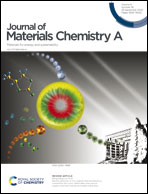Tailoring the electronic structure by constructing the heterointerface of RuO2–NiO for overall water splitting with ultralow overpotential and extra-long lifetime†
Abstract
The rational design of highly efficient and stable electrocatalysts remains a challenge for large scale hydrogen production. Regulating the heterointerface between two catalyst components could effectively modulate the electronic structure and tune the electrocatalytic activity. Herein, a hybrid RuO2–NiO electrocatalyst on nickel foam was prepared via a simple and easy industrial scale-up approach, which affords a current density of 10 mA cm−2 at low overpotentials of 18 mV for HER and 187 mV for OER, respectively. The electrolyzer assembled by the RuO2–NiO bifunctional electrode needs a cell voltage of only 1.43 V to reach 10 mA cm−2 for the overall water splitting. Moreover, the electrolyzer achieved an outstanding activity and stability at high current densities, which needed a cell voltage of only 1.66 V to reach 500 mA cm−2, and could perform continuous electrolysis for 2000 hours at 1000 mA cm−2, thereby demonstrating a great potential for practical applications. Theoretical calculations revealed that the coupling of RuO2 and NiO could greatly accelerate water dissociation and modulate the chemisorption of hydrogen and oxygen-containing intermediates on the catalyst, and consequently enhance the intrinsic activity towards both HER and OER.



 Please wait while we load your content...
Please wait while we load your content...